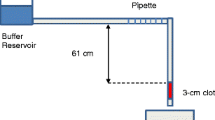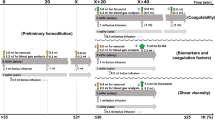Abstract
Hydroxyethyl starch (HES) is one of the most frequently used plasma substitutes. A variety of different HES solutions exist worldwide, which differ greatly in their pharmacological properties. HES is classified according to its manufactured or in vitro molecular weight (MW) into high MW (450–480 kDa), medium MW (200 kDa), and low MW (70 kDa) starch preparations. However, this is not sufficient, because as HES is metabolized in vivo, its MW changes, and it is the in vivo MW which is responsible for the therapeutic and adverse effects of each HES. The rate of metabolization depends mainly on the degree of hydroxyethyl substitution (ranging from 0.4 to 0.7), and the C2/C6 ratio of hydroxyethylation. A high degree of substitution and a high C2/C6 ratio lead to a slow metabolization of HES, resulting in a large in vivo MW. Slowly degradable high MW HES 450/0.7 and medium MW HES 200/0.62 have a high in vivo MW and are eliminated slowly via the kidneys. As a result, these starches have a relatively long-lasting volume effect. When infusing higher volumes ( > 1500 ml) are infused, large molecules accumulate in the plasma. This can result in bleeding complications due to decreased factor VIII/von Willebrand factor, platelet function defects, incorporation into fibrin clots, and an unfavorable effect on rheological parameters. Rapidly degradable medium MW HES 200/0.5 or low MW HES 70/0.5 are quickly split in vivo into smaller, more favorable molecule sizes, resulting in faster renal elimination, shorter volume effect, and fewer adverse effects on coagulation and rheological parameters. For historical and marketing reasons, only slowly degradable, high MW HES (480/0.7) is available in the United States. In Europe, a large variety of HES solutions are available, dominated by medium MW, easily degradable HES (200/0.5). Because of increasing international competition and the availability of newly developed starches, it is important to be aware of the pharmacological properties of HES and the advantages and disadvantages of the individual preparations.
Similar content being viewed by others
Author information
Authors and Affiliations
Additional information
Received: 1 January 1998 Accepted: 17 August 1998
Rights and permissions
About this article
Cite this article
Treib, J., Baron, JF., Grauer, M. et al. An international view of hydroxyethyl starches. Intensive Care Med 25, 258–268 (1999). https://doi.org/10.1007/s001340050833
Issue Date:
DOI: https://doi.org/10.1007/s001340050833




